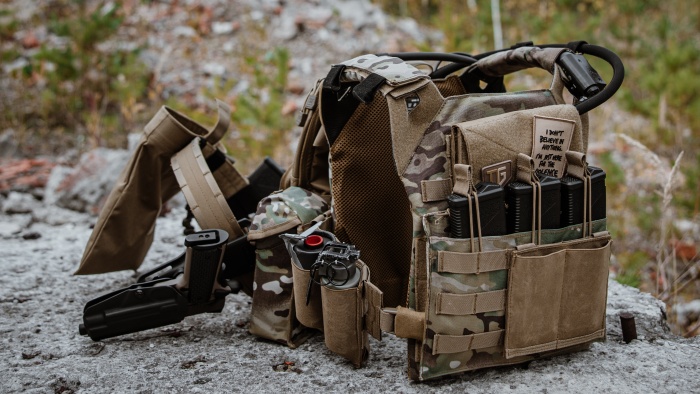Walking With Weights: Benefits Of Improve Your Fitness And Health

Are you seeking a fresh twist in your walking routine? Walking with weights, specifically using a weighted vest, offers a unique opportunity to bypass the gym while still enhancing your physical and mental strength.
If you, like me, prefer basking in the beauty of nature for your exercise rather than enduring a gym bathed in fluorescent lights and filled with odors, think about incorporating a weighted vest or a hydration hiking bladder into your hike, walk, or fitness regimen.
| Not only does this boost the intensity of your exercise, but it also contributes to increasing your overall strength and endurance, bone density, and posture. |
Isn’t that something we could all benefit from? 😃

In Brief:
Enhancing your walks with a weighted vest can elevate the intensity of your exercise, leading to higher calorie burn.
This addition can bolster your overall strength and endurance, as well as enhance bone density and posture.
Incorporating a weighted vest into your walking regimen offers a challenging yet rewarding workout experience.
Continue to the end to discover how a hydration bladder can double as a weighted vest, offering dual functionality!
Advice from a physiotherapist who loves hiking
A key advantage of walking with a weighted vest is the amplified calorie expenditure. When you add additional weight to your frame, your body has to exert more effort, leading to a greater calorie burn. This is particularly advantageous for those aiming to shed pounds or enhance their cardiovascular fitness.
Moreover, walking with added weight can aid in bolstering your balance and stability, as it necessitates the engagement of your core muscles to sustain correct posture.
Key advantages of walking with a weighted vest
Seeking an exciting twist to your regular walks? Consider integrating a weighted vest. Utilizing a weighted vest while walking comes with several benefits: enhanced calorie burning, increased strength and endurance, improved bone density, and better posture.

Elevated calorie burning 🔥
Walking while wearing a weighted vest amplifies your calorie expenditure. A study involving 13 women revealed that walking at 2.5 mph with a weighted vest resulted in a 12% boost in kilocalorie burn. The extra weight heightens the energy needed for the same movements, leading to more calories burned.
Boosted strength and endurance 💪
The resistance from a weighted vest can also heighten your muscular strength and endurance. The additional resistance forces your muscles to work harder during familiar movements, potentially leading to increased muscle mass and overall fitness enhancement.
Enhanced bone density and posture 🧘
Incorporating a weighted vest in your walking routine can also elevate your bone density and posture. The extra weight applies pressure on your bones, promoting the development of new bone cells, which is vital in combating bone loss. Plus, wearing a weighted vest can improve your posture by altering your center of gravity and engaging your core muscles more effectively.
When selecting a weighted vest, it’s crucial to begin with a weight that matches your fitness level. The American Council on Exercise advises starting with a vest weighing 5-10% of your body weight, and then gradually increasing the weight as your fitness improves.
Walking with a weighted vest offers various benefits to your fitness regimen. However, always consult a healthcare professional before beginning any new exercise program, particularly if you have underlying health conditions like arthritis or spinal stenosis.
| | Tip
Enhance your outdoor workouts with this Adjustable Weighted Vest. Experience safe walking with reduced bounce compared to typical weighted vests, aiding in building strength! |
In-depth analysis(enhanced calorie burning with weighted vest)
Looking to ramp up calorie burning during your walks? Adding a weighted vest to your walking routine can significantly increase your energy expenditure, leading to a more intense calorie burn and potential weight loss. This section delves into the mechanisms of how walking with a weight vest amplifies calorie burning and offers strategies to optimize your outcomes.
Mechanism behind Calorie burn increase with weight vest walking
Walking while donning a weighted vest adds extra load for your body to carry, demanding more energy, thus escalating calorie expenditure. Research involving 13 women showed that walking at a speed of 2.5 mph with a weighted vest resulted in a 12% uptick in kilocalorie burn.
Moreover, the added resistance from the vest not only boosts your cardio and speed training but also aids in muscle development, especially targeting your core, quadriceps, and hamstrings. This leads to enhanced overall fitness and body composition.
Strategies to maximize Calorie burning
To optimize calorie burn when walking with a weighted vest, consider these tips:
- Begin with a Lighter Weight: For those new to weighted vest walking, start with a lighter vest and progressively increase the weight as your body adjusts to the extra resistance. A vest weighing 5-10% of your body weight is an ideal starting point.
- Vary Your Walking Routine: Change up your walking distance, incline, and pace to continuously challenge your body and avoid hitting a fitness plateau. Integrating bodyweight exercises such as pushups or squats can also amplify calorie burning.
- Prioritize Safety: Opt for an adjustable vest that snugly fits your body to avert injuries and maintain proper form. Avoid overly heavy vests or tactical types, as they can exert undue stress on your bones and joints.
- Seek Professional Advice: If you’re new to exercising or have pre-existing health issues, it’s wise to consult a fitness or medical professional before including weighted vest walking in your regimen. They can offer tailored advice for safely and effectively utilizing a weighted vest according to your specific requirements.
Comprehensive analysis(boosting strength and endurance with a weight vest)
Enhancing strength and endurance through weight vest walking
Incorporating a weighted vest into your walking routine is a potent method to escalate both your strength and endurance. The extra load challenges your muscles beyond the intensity of a standard walk. This resistance is key in building muscle mass and augmenting overall strength.
Additionally, weighted vest walking elevates endurance. The extra weight raises your energy demands, making your body exert more effort for the same walking distance. This heightened effort, over time, contributes to improved cardiovascular fitness and faster running speeds.
Strategies to enhance strength and endurance
To fully leverage the strength and endurance advantages of walking with a weighted vest, consider these tips:
- Begin with a Moderate Weight: For newcomers to weighted vest walking, a vest weighing 5% to 10% of your body weight is ideal. As your comfort with the added load increases, you can progressively raise the vest’s weight.
- Maintain Proper Posture: Good posture is vital when walking with a weighted vest to ensure balance and stability. Keep your shoulders retracted, your core engaged, and your hips aligned with your feet.
- Include Inclines and Sprints: For an additional challenge, integrate inclines and sprints into your routine. This variation not only increases power but also strengthens muscles in your quadriceps and hamstrings.
- Consult a Healthcare Expert: Prior to embarking on a weighted vest walking program, especially if you have any medical conditions or concerns, it’s crucial to seek advice from a medical professional.
By adhering to these guidelines and gradually increasing the weight of your vest, you can condition your body to the added resistance and maximize the benefits of this resistance training form.
Enhancing bone density and posture with weight vest walking
How walking with a weight vest benefits bone density and posture
Integrating a weighted vest into your walking routine can significantly benefit bone density and posture. Harvard Health notes that exercising with added weight applies pressure on bones, prompting them to strengthen. This aspect is crucial for older adults or individuals with osteoporosis, as bone density naturally diminishes with age.
Moreover, walking with a weighted vest can enhance posture. The additional weight compels your body to maintain proper alignment, aiding in the prevention of slouching and related posture issues. Additionally, it strengthens back and core muscles, which are vital for maintaining good posture.
Strategies to optimize bone density and posture benefits
To fully reap the bone density and posture benefits of weighted vest walking, consider the following strategies:
- Start with a Manageable Weight: American Bone Health recommends beginning with a vest weighing between 4% to 10% of your body weight. For instance, if you weigh 150 pounds, opt for a vest weighing 6 to 15 pounds.
- Progressively Increase Weight: As your body gets accustomed to the extra weight, gradually increase the vest’s weight. This ensures ongoing challenges for your bones and muscles.
- Maintain Correct Walking Form: For optimal posture benefits, keep proper walking form. Shoulders should be pulled back and down, chest up, and core engaged. Avoid slouching or leaning forward.
- Wear Appropriate Footwear: Given the additional strain on your feet and ankles when walking with a weighted vest, it’s important to wear supportive, well-cushioned shoes.
By following these guidelines and gradually adapting to the added weight, you can enhance your bone density and posture, gaining the full benefits of weighted vest walking.

Options beyond weighted vests
Enhancing your hiking or walking routine doesn’t always require investing in a specialized, single-purpose item like a weighted vest. A method I particularly enjoy intensifying my hiking workouts involves using a hydration bottle filled with water. This not only adds weight but also lightens as I drink more – it’s a double benefit!
Many hydration bottles come with small pockets where you can carry essentials. For extra weight, consider adding items like cornhole bags into these pockets, effectively increasing the load during your walk.
Precautions and considerations for weighted vest walking
While weighted vest walking offers numerous benefits for strength, endurance, and overall fitness, there are important precautions and considerations to keep in mind to ensure safety and effectiveness. These considerations should complement the information already provided, without repetition:
- Listen to Your Body: Pay attention to how your body responds to the added weight, especially if you’re new to weighted vest walking. If you experience any pain or discomfort, adjust the weight or take a break.
- Gradual Progression: It’s important to increase the weight and intensity of your walks gradually. Sudden increases in weight can lead to strain and injury.
- Stay Hydrated: The additional effort required for weighted vest walking means your body will need more hydration. Carry water with you, especially during longer walks or in hot weather.
- Balance Your Workouts: Combine weighted vest walking with other forms of exercise for a well-rounded fitness routine. This helps prevent overuse injuries and ensures balanced muscle development.
- Proper Nutrition: Given the increased physical demand, ensure you are fueling your body with a balanced diet rich in nutrients to support muscle recovery and energy needs.
- Weather Considerations: Be mindful of the weather conditions. In hot climates, the extra weight and exertion can increase the risk of overheating. In cold conditions, ensure adequate clothing to maintain body heat.
- Check Vest Fit Regularly: Regularly check the fit of your weighted vest. A poorly fitted vest can cause discomfort and affect your posture and walking form.
- Mind Your Terrain: Be cautious of the terrain you choose for your walks. Uneven or slippery surfaces can increase the risk of falls, especially with the added weight.
- Consult Experts Regularly: Regularly consulting with fitness professionals can provide insights into your progress and help adjust your routine for maximum benefit and safety.
- Rest and Recovery: Incorporate rest days into your routine to allow your body to recover. Overtraining can lead to fatigue and increased risk of injury.

Conclusion
Walking with weights, particularly through the use of a weighted vest, can be an incredibly effective way to elevate your exercise routine. It not only intensifies calorie burn but also significantly enhances overall fitness, including strength, endurance, bone density, and posture.
By commencing with a manageable weight and progressively increasing the resistance, you can adapt comfortably to the added challenge. Additionally, blending in bodyweight exercises and maintaining a focus on safety are key to optimizing the benefits of this dynamic form of exercise.
Remember, while the rewards of walking with weights are substantial, it’s crucial to listen to your body and make adjustments as needed. Hydration, balanced nutrition, and appropriate rest are vital to support your fitness journey. With these strategies in place, you’re well on your way to enjoying a healthier, stronger you.
| | Tip
Revel in the beauty of the outdoors with this Adjustable Weighted Vest. Experience a safer and more effective workout with less bounce compared to standard weighted vests, helping you to build strength and resilience in nature’s embrace! |
FAQs
Can walking with a weighted vest improve cardiovascular health?
Yes, walking with a weighted vest can significantly improve cardiovascular health. The added weight increases the heart rate and oxygen consumption during the walk, providing a more intense cardiovascular workout compared to regular walking. This can lead to improvements in heart health and endurance over time.
Is it safe for everyone to walk with a weighted vest?
While weighted vest walking is generally safe, it’s not suitable for everyone. Individuals with joint problems, back pain, or cardiovascular issues should consult with a healthcare professional before starting. It’s also essential for beginners to start with a lower weight and gradually increase as their fitness improves.
How often should I walk with a weighted vest?
The frequency of weighted vest walks depends on your overall fitness goals and current activity level. Generally, starting with 2-3 times per week and gradually increasing as you become more comfortable can be beneficial. It’s important to balance these walks with rest days to allow for recovery.
Can weighted vest walking help with weight loss?
Yes, walking with a weighted vest can aid in weight loss as it increases the number of calories burned during the walk. Combined with a healthy diet and regular exercise, it can be an effective tool for weight loss and body composition improvement.
What should I wear for a weighted vest walk?
Comfortable, breathable clothing suitable for the weather conditions is recommended. Supportive, cushioned footwear is essential to provide adequate support and cushioning for the increased impact of the added weight. It’s also a good idea to wear moisture-wicking fabrics to stay cool and dry.

